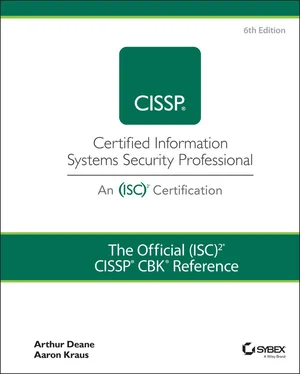DETERMINE COMPLIANCE AND OTHER REQUIREMENTS
(ISC) 2defines compliance as adherence to a mandate; it includes the set of activities that an organization conducts to understand and satisfy all applicable laws, regulatory requirements, industry standards, and contractual agreements.
Legislative and Regulatory Requirements
Many compliance expectations come from statutory or regulatory requirements that apply broadly to all industries. Others are specific to certain industries or products. This ever-changing set of expectations requires a continuous review of organizational practices to ensure that information is protected in compliance with all applicable requirements.
NOTEBecause there are many compliance requirements that relate to information security, many people often confuse the two or assume that being compliant is the same as being secure. As a CISSP, you should understand that compliance requirements generally serve as a solid baseline for security, but being compliant with security regulations and standards is only the first step toward being secure.
The first challenge in identifying compliance requirements involves knowing which jurisdiction has the legal authority to set those requirements. Jurisdiction is a legal concept that establishes the official power to make legal decisions and judgments. It is not enough to know the relevant geography or political boundaries; jurisdiction may also be influenced by international treaties and agreements, the activity of your organization, or any number of other factors. Regardless of the example laws and regulations listed in this text, information security practitioners must be aware of the nuances of the jurisdictions in which they operate.
In most jurisdictions, laws are established to define what is permissible and what is not. In U.S. law, the word law refers to any rule that, if broken, subjects a party to criminal punishment or civil liability. Laws may be generally categorized into two parts: statutes and regulations. Statutes are written and adopted by the jurisdiction's legislative body (e.g., U.S. Congress), while regulations are more detailed rules on how the execution of a statute will be performed. Both statutes and regulations are legally enforceable, but regulations are subordinate to statutes.
TIPWhile you don't need a law degree to be an information security professional, it certainly helps to Article 17 have a basic understanding of legal jargon. Since you must learn to read laws and understand how they apply to information security, it's important that you can interpret how laws are usually cited, particularly in the United States. If you see 18 U.S.C. § 1030, for example, you should understand that this refers to Section 1030 of Title 18 of the United States Code. You may see C.F.R. used to reference the Code of Federal Regulations. In the United Kingdom, laws are cited in the following manner: Title of Act Year, Chapter Number (where the chapter is optional); “Computer Misuse Act 1990, c. 18” is an example.
There is a growing number of legislative and regulatory requirements in the United States and around the world, but there are two overarching U.S. laws that you should be familiar with:
U.S. Computer Security Act of 1987
U.S. Federal Information Security Management Act (FISMA) of 2002
U.S. Computer Security Act of 1987
The Computer Security Act was enacted by the U.S. Congress in 1987 with the objective of improving the security and privacy of sensitive information stored on U.S. federal government computers. The act contains provisions that require establishment of minimally acceptable security practices for federal government computer systems, as well as establishment of security policies for government agencies to meet those practices. As part of this act, security awareness training was established as a requirement for any federal government employee using government computer systems.
The Computer Security Act establishes that the National Institute for Standards and Technology, an agency within the U.S. Department of Commerce, is responsible for setting computer security standards for unclassified, nonmilitary government computer systems, while the National Security Agency (NSA) is responsible for setting security guidance for classified government and military systems and applications.
The Computer Security Act of 1987 was repealed by the Federal Information Security Management Act (FISMA) of 2002, which is discussed next.
U.S. Federal Information Security Management Act (FISMA) of 2002
The Federal Information Security Management Act, commonly referred to as FISMA (pronounced “fizz-muh”), is a U.S. law enacted in 2002 that greatly extends the Computer Security Act of 1987. FISMA acknowledges the importance of information security to the United States' economic and national security interests and requires that all U.S. federal government agencies and nongovernment organizations that provide information services to these agencies conduct risk-based security assessments that align with the NIST Risk Management Framework (RMF).
Industry Standards and Other Compliance Requirements
Aside from national, state, and local laws and regulations, your organization may be required to comply with certain regulations and standards based on your industry or the type of services you provide. The most prominent industry standards that you should be aware of include the following:
U.S. Sarbanes–Oxley Act of 2002 (SOX)
System and Organization Controls (SOC)
Payment Card Industry Data Security Standard (PCI DSS)
U.S. Sarbanes–Oxley Act of 2002
Following several high-profile corporate and accounting scandals, the SOX was enacted in the United States to reestablish public trust in publicly traded companies and public accounting firms. SOX required companies to implement a wide range of controls intended to minimize conflicts of interest, provide investors with appropriate risk information, place civil and criminal penalties on executives for providing false financial disclosures, and provide protections for whistleblowers who report inappropriate actions to regulators.
Under SOX, the Public Company Accounting Oversight Board (PCAOB) was established as a nonprofit organization responsible for overseeing the implementation of SOX. PCAOB's “Auditing Standards” identify the role that information systems play in maintaining financial records and requires auditors to assess the use of IT as it relates to maintaining and preparing financial statements. As part of PCAOB standards, auditors should broadly consider information security risks that could have a material impact on a company's financial statements. Even though SOX is largely a financially focused law, the regulation has a real and growing impact on IT and information security.
System and Organization Controls
Often confused with SOX (discussed previously), SOC stands for System and Organization Controls and is an auditing framework that gives organizations the flexibility to be audited based on their own needs. There are three commonly used types of SOC audits and reports, aptly named SOC 1, SOC 2, and SOC 3. The three audit and report types align with standards outlined in Statement on Standards for Attestation Engagements (SSAE) 18, which was published by the American Institute of Certified Public Accountants (AICPA) in 2017 (with amendments made via SSAE 20 in 2019).
SOC 1: An audit and compliance report that focuses strictly on a company's financial statements and controls that can impact a customer's financial statements. A company that performs credit card processing is likely to require a SOC 1 audit and compliance report.
Читать дальше












